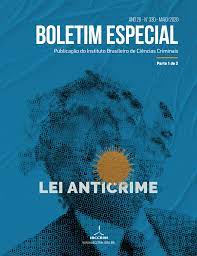Anti-crime statute law and recidivism: na approach to the criminal law of the agent
Views: 187Keywords:
Anti-crime Statute Law, Recidivism, Criminal Law of the AgentAbstract
This paperwork discourses about given by the just ratified “Anti-crime Statute Law” to recidivism, starting from three points: the insertion of the paragraph 2nd to the Article 310 of the Criminal Procedural Code; the modification to the Article 112 of the Statute Law 7.210/1984; and on the Article 20 of the Statute Law 10.826/2003. It concludes that the three points confer a highlighted role to recidivism, approaching the brazilian Criminal Law to the undesirable Criminal Law of the Agent.
Downloads
Publication Facts
Reviewer profiles N/A
Author statements
- Academic society
- Instituto Brasileiro de Ciências Criminais
- Publisher
- IBCCRIM
References
BOSCHI, José Antônio Paganella. Das penas e seus critérios de aplicação. 7. ed. Porto Alegre: Livraria do Advogado, 2014.
CASTIÑEIRA, Maria Teresa; RAGUÉS, Ramón. Three strikes: el principio de proporcionalidad en la jurisprudencia del Tribunal Supremo de los Estados Unidos. Revista de Derecho Penal y Criminologia, Madrid, n. 14, pp. 58-85, 2004.
EL HIRECHE, Gamil Föppel e FIGUEIREDO, Rudá Santos. Crítica às tipificações relativas ao tratamento do “crime organizado” no projeto de código penal e na lei 12.850/2003. In: BADARÓ, Gustavo Henrique. Doutrinas essenciais: direito penal e processo penal. Vol. VI. São Paulo: Revista dos Tribunais, 2015. pp. 427-474.
HASSEMER, Winfried. ¿Por qué castigar? Razones por las que merece la pena la pena. Trad. Manuel Cancio Meliá e Francisco Muñoz Conde. Valencia: Tirant lo blanch, 2016
ROTHENBURG, Walter Claudius. Igualdade material e discriminação positiva: o princípio da isonomia. Novos Estudos Jurídicos, Itajaí, v. 13, n. 2, pp. 77-92, 2008.
ROXIN, Claus. Derecho penal: parte general. Trad. Diego-Manuel Luzón Peña, Miguel Díaz y Garcia Conlledo, Javier de Vicente Remesal. Madrid: Civitas, 1997.
SABOYA, Keity. Ne bis in idem: história, teoria e perspectiva. Rio de Janeiro: Lumen Juris, 2014.
Downloads
Published
How to Cite
Issue
Section
License
Copyright of published articles belongs to the author, but with journal rights over the first publication and respecting the one-year exclusivity period. Authors may only use the same results in other publications by clearly indicating this journal as the medium of the original publication. If there is no such indication, it will be considered a situation of self-plagiarism.
Therefore, the reproduction, total or partial, of the articles published here is subject to the express mention of the origin of its publication in this journal, citing the volume and number of this publication. For legal purposes, the source of the original publication must be consigned, in addition to the DOI link for cross-reference (if any).


 Português (Brasil)
Português (Brasil)
 English
English
 Español (España)
Español (España)






